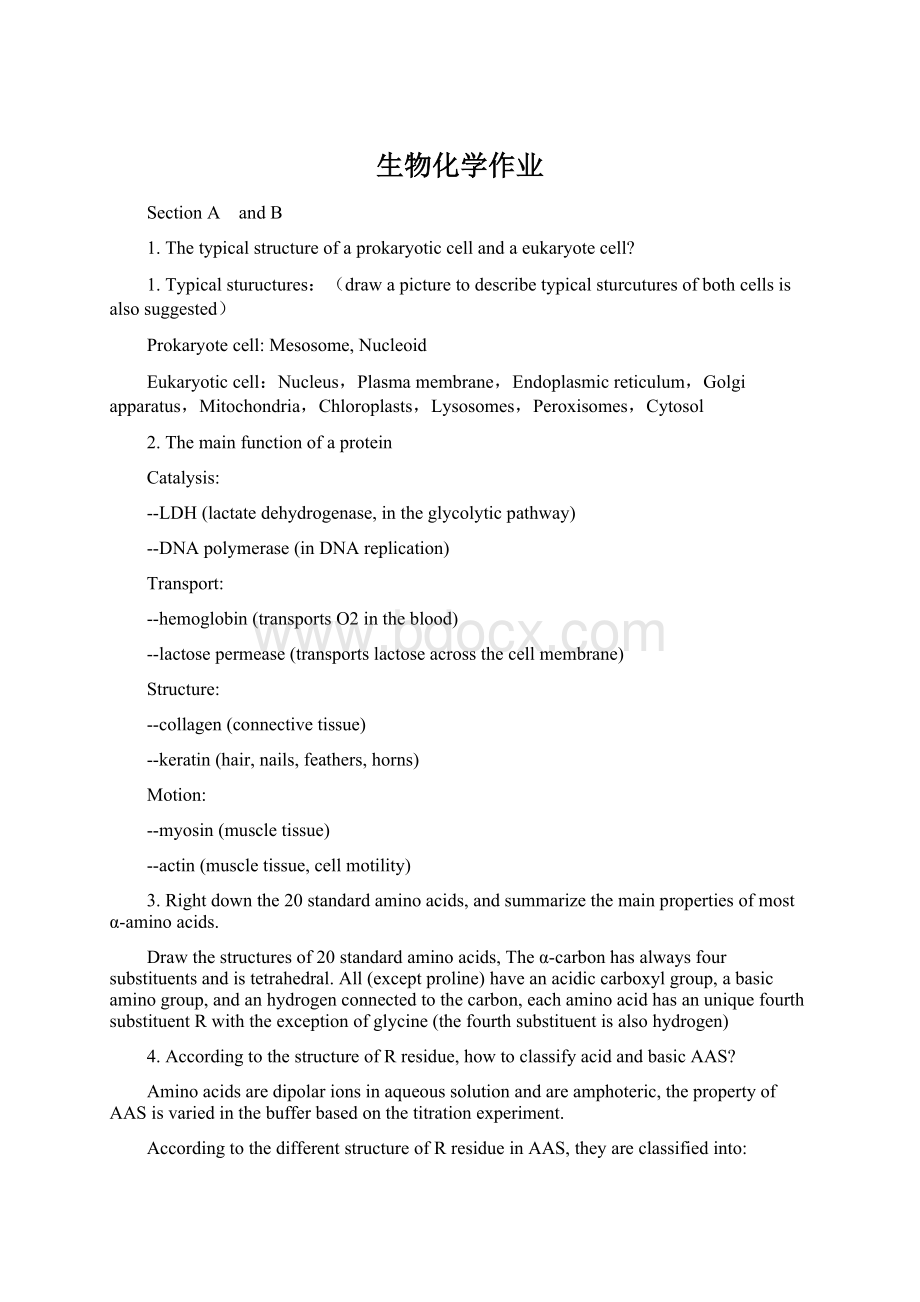生物化学作业.docx
《生物化学作业.docx》由会员分享,可在线阅读,更多相关《生物化学作业.docx(14页珍藏版)》请在冰豆网上搜索。

生物化学作业
SectionA andB
1.Thetypicalstructureofaprokaryoticcellandaeukaryotecell?
1.Typicalstuructures:
(drawapicturetodescribetypicalsturcuturesofbothcellsisalsosuggested)
Prokaryotecell:
Mesosome,Nucleoid
Eukaryoticcell:
Nucleus,Plasmamembrane,Endoplasmicreticulum,Golgiapparatus,Mitochondria,Chloroplasts,Lysosomes,Peroxisomes,Cytosol
2.Themainfunctionofaprotein
Catalysis:
--LDH(lactatedehydrogenase,intheglycolyticpathway)
--DNApolymerase(inDNAreplication)
Transport:
--hemoglobin(transportsO2intheblood)
--lactosepermease(transportslactoseacrossthecellmembrane)
Structure:
--collagen(connectivetissue)
--keratin(hair,nails,feathers,horns)
Motion:
--myosin(muscletissue)
--actin(muscletissue,cellmotility)
3.Rightdownthe20standardaminoacids,andsummarizethemainpropertiesofmostα-aminoacids.
Drawthestructuresof20standardaminoacids,Theα-carbonhasalwaysfoursubstituentsandistetrahedral.All(exceptproline)haveanacidiccarboxylgroup,abasicaminogroup,andanhydrogenconnectedtothecarbon,eachaminoacidhasanuniquefourthsubstituentRwiththeexceptionofglycine(thefourthsubstituentisalsohydrogen)
4.AccordingtothestructureofRresidue,howtoclassifyacidandbasicAAS?
Aminoacidsaredipolarionsinaqueoussolutionandareamphoteric,thepropertyofAASisvariedinthebufferbasedonthetitrationexperiment.
AccordingtothedifferentstructureofRresidueinAAS,theyareclassifiedinto:
“Acidic”aminoacids:
containingadditionalcarboxylgroupswhichareusuallyionized.Thoseaminoacidswithanionizableside-chain(Asp,Glu,Arg,Lys,His,Cys,Tyr)haveanadditionalacid–basegroup.
“Basic”aminoacids:
containingpositivelychargedgroupssuchasArgandLys.
5.Whatisthetypicalstructureinthesecondarystructureofaprotein?
Secondarysturctureinaproteinreferstotheregularfoldingofregionsofthepolypeptidechain.Thetwomostcommontypesarethea-helix,𝛽-sheet.
6.Whatisthenoncovalentinteractionbetweensidechainsthatholdthetertiarystructuretogether?
Noncovalentinteractionbetweensidechainsthatholdthetertiarystructuretogether:
vanderWaalsforces,hydrogenbonds,electrostaticsaltbridges,hydrophobicinteractions.
7.Definitions:
1.Flowcytometry:
Individualcellscanbeidentifiedusingaflowcytometer.Antibodies,coupledtofluorescentcompounds,thatbindtomoleculesonthesurfaceofparticulartypesofcellscanbeusedtoseparatecellsfromeachotherinafluorescence-activatedcellsorter(FACS).
2.Enantiomers:
FourdifferentgroupsarrangedtetrahedrallyaroundtheCatomandthuscanexistineithertheDorLconfiguration.Thesetwoenantiomersarenonsuperimposablemirrorimagesthatcanbedistinguishedonthebasisoftheirdifferentrotationofplane-polarizedlight.
3.Peptidebond:
Thepeptidebondisacovalentbondbetweentheα-aminogroupofoneaminoacidandtheα-carboxylgroupofanother.
4.Primarystructure:
Thelinearsequenceofaminoacidsjoinedtogetherbypeptidebondsistermedtheprimarystructureoftheprotein.Thepositionofcovalentdisulfidebondsbetweencysteineresiduesisalsoincludedintheprimarystructure.
5.Secondarystructure:
Secondarystructureinaproteinreferstotheregularfoldingofregionsofthepolypeptidechain.
6.Tertiarystructure:
Tertiarystructureinaproteinreferstothethree-dimensionalarrangementofalltheaminoacidsinthepolypeptidechain.Thisbiologicallyactive,nativeconformationismaintainedbymultiplenoncovalentbonds.
7.Quaternarystructure:
Ifaproteinismadeupofmorethanonepolypeptidechainitissaidtohavequaternarystructure.Thisreferstothespatialarrangementofthepolypeptidesubunitsandthenatureoftheinteractionsbetweenthem.
8.Protheticgroups:
Ametalorcoenzymethatiscovalentlyattachedtotheenzymeiscalledaprostheticgroup.
9.Motif:
aregroupingsofsecondarystructuralelementsthatfrequentlyoccuringlobularproteins.Theyoftenhavefunctionalsignificanceandcanrepresenttheessentialpartsofbindingorcatalyticsitesthathavebeenconservedduringtheevolutionof
proteinfamiliesfromacommonancestor.
10.Domain:
Structurallyindependentunits,orfamiliesthatareconnectedbysectionswithlimitedhigherorderstructurewithintheevolutionsamepolypeptide.
11.Ionexchangechromatography:
isachromatographyprocessthatseparatesionsandpolarmoleculesbasedontheiraffinitytotheionexchanger,proteinsareseparatedonthebasisoftheiroverall(net)charge.
12.Affinitychromatography:
Affinitychromatographyexploitsthespecific,highaffinity,noncovalentbindingofaproteintoanothermolecule,theligand.thistechniqueexploitsthespecific,oftenunique,bindingpropertiesoftheprotein,itisoftenpossibletoseparatetheproteinfromamixtureofhundredsofotherproteinsinasinglechromatographicstep.
HomeworkforsectionC,D
1.Writedownthefollowingdefinitions:
Activesite,prostheticgroups,isoenzyme,freeenergychange,monoclonalantibody.
Activesite:
Theregionoftheenzymethatbindsthesubstrate,totransformsitintoproduct.
Coenzymes:
Manyenzymesrequirethepresenceofsmall,nonproteinunitsorcofactorstocarryouttheirparticularreaction.Acomplexorganicmoleculecalledacoenzyme.
Prostheticgroups:
cofactorsmaybeinorganicionsorcomplexorganicmolecules,someofcofactorsthatcovalentlyattachedtotheemzymeiscalledprotheticgroups.
Isoenzyme:
isoenzymesaredifferentformsofanenzymewhichcatalyzethesamereaction,butwhichexhibitdifferentphysicalorkineticproperties.
Freeenergychange:
ThedifferenceinenergylevelbetweenthesubstratesandproductistermedthechangeinGibbsfreenergy(ΔG).
Monoclonalantibody:
Antibodyproducedbyasinglecloneofcellsisamonoclonalantibody,whichareidenticalandbindtothesameantigenicsitewithidenticalbindingaffinities.
Complement:
Thecomplementsystemisapartoftheimmunesystemthatenhances(complements)theabilityofantibodiesandphagocyticcellstoclearmicrobesanddamagedcellsfromanorganism,promotesinflammation,andattacksthepathogen'splasmamembrane.(不需要完全记住,理解即可)
2.Listthesixmainclassesofenzymesclassifiedbythereactiontheycatalyze.
3.Whatisenzymevelocity?
Pleasesetthelimitationfactorsthatinfluencetheenzymevelocity.
Enzymevelocityreferstotherateofanenzyme-catalyzedreaction.Thelimitationfactorsincludessubstrateconcentration;enzymeconcentration;temperature;pH.
4.Whatisthefeedbackregulation?
Andpleasesetanexampleforfeedbackregulationinitsimplicationinmetabolicregulation.
Afeedbackregulationisusuallyfoundinmetabolicregulationwhenanenzymeearlyoninthepathwayisinhibitedbyanend-productofthemetabolicpathwayinwhichitisinvolved.
5.Whatisthebasicstructureofanallostericenzyme?
Allostericenzymes are enzymes thatchangetheir conformationalensemble uponbindingofan effector,whichresultsinanapparentchangeinbindingaffinityatadifferentligandbindingsite.(Inallostericenzmes,thebindingofasubstratemoleculetooneactivesiteaffectsthebindingofsubstratemoleculestootheractivesitesintheenzyme;thedifferentactivesitesaresaidtobehavecooperativelyinbindingandactingonsubstratemolecules.)
6.Whatisthemainfunctionofimmunesystem?
Theimmunesystemhastwomainfunctions;torecognizeinvadingpathogensandthentotriggerpathwaysthatwilldestroythem.
7.WhatisthebasicstructureandmainfunctionofIgG?
EachIgGantibodymoleculeconsistsoffourpolypeptidechains(twoidenticallightchainsandtwoidenticalheavychainsjoinedbydisulfidebonds)andhastwoantigen-bindingsites.Itprovidesthemajorityofantibody-basedimmunityagainstinvadingpathogensandactivatecomplementandtriggermacrophages,butistheonlyantibodythatcanpassthroughtheplacentaandsoprovideimmunologicalprotectionforthefetus.
8.Whatistheclonalselectiontheoryinhumoralimmunesystem?
Youcansimplydescribethisprocessbyapicture.
Alargenumberofantibody-producingcellsexistinananimalevenbeforeitencountersaforeignantigen,eachcellproducingonlyonespecificantibodyanddisplayingthisonitscellsurface.Anantigenbindstocellsthatdisplayantibodieswithappropriatebindingsitesandcausesproliferationofthosecellstoformclonesofcellssecretingthesameantibodyinhighconcentration.
9.Pleasesettwoexamplesformonoclonalantibodyimplicationinclinicaldiagnosisandtherapy.
Anyspecificexampleinmonoclonaltherapyordiagnosisyoucanfindinthefollowingfigure:
SectionE
1.Describethebasicstructureofcellmembrane?
Whatisthemaincomponentofmembranelipids?
Allmembranescontaintwobasiccomponents:
lipidsandproteins.Somemembranesalsocontaincarbohydrate.Thecompositionoflipid,proteinandcarbohydratevariesfromonemembranetoanother.Therearethreemajortypesoflipid:
theglycerophospholipidsthesphingolipidsandthesterols.
2.Whatisthetypicalstructurewithinanintergralprotein?
Mostintegralproteinshaveoneormoreregionsofthehydrophobicpolypeptidechainthattraversethelipidbilayer.Theseregionsconsistmainlyofaminoacidswithhydrophobicside-chainsthatfoldintoanα-helixandinteractnoncovalentlywiththesurroundinglipids.
3.Describetheprocessofglucosetransportintoerythrocytes(anexampleinpassivetransport),andglucosetransportintointerstinalepithelialcells(anexampleinactivetransport),andexplainthemaindifferencebetweenthem.
Homeworkforsectio